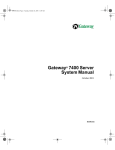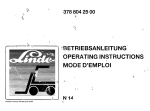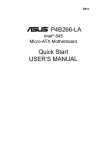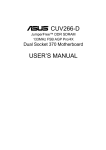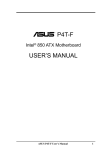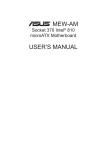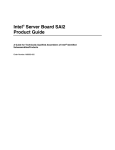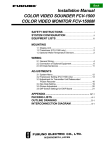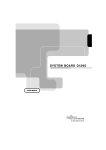Download Fujitsu D1241 User's Manual
Transcript
• • • http://www.fujitsu-siemens.com ! " # $ %& '( ) * +,&- ,. ' * /* 0100 01&00 A26361-D1241-Z120-1-7619 ! " #$ %&&& ''( )* +", ' '" '"-*)" . / ' "0% )"0% . 1 ' , / / / , ) / , * ! 2 CONTENTS 1. INTRODUCTION ............................................................................. 7 1.1 How This Manual Is Organized .................................................. 7 1.2 Item Checklist ............................................................................. 7 2. FEATURES ........................................................................................ 8 2.1 The motherboard.......................................................................... 8 2.1.1 Specifications .................................................................. 8 2.1.2 Specifications–Optional Components ............................. 9 2.1.3 Performance ................................................................... 10 2.1.4 Intelligence .................................................................... 11 2.2 Motherboard Components ........................................................ 12 2.2.1 Component Locations .................................................. 13 3. HARDWARE SETUP ...................................................................... 14 3.1 Motherboard Layout ................................................................. 14 3.2 Layout Contents ........................................................................ 15 3.3 Hardware Setup Procedure ....................................................... 16 3.4 Motherboard Settings ................................................................ 16 3.5 System Memory (DIMM) ......................................................... 17 3.5.1 SDRAM Configurations ................................................ 17 3.5.2 DIMM Installation ......................................................... 18 3.6 Central Processing Unit (CPU) ................................................. 19 3.7 Expansion Cards ....................................................................... 20 3.7.1 Expansion Card Installation Procedure ......................... 20 3.7.2 Assigning IRQs for Expansion Cards ............................ 21 3.8 Connectors ................................................................................ 22 SCSI Connection Notes ............................................................ 32 3.9 Starting Up the First Time ........................................................ 33 4. BIOS SETUP ..................................................................................... 35 4.1 Managing and Updating Your BIOS ......................................... 35 4.1.1 Upon First Use of the Computer System ....................... 35 4.1.2 Updating BIOS Procedures ........................................... 36 4.2 BIOS Setup Program ................................................................ 39 4.2.1 BIOS Menu Bar ............................................................. 40 4.2.2 Legend Bar .................................................................... 40 4.3 Main Menu ................................................................................ 42 4.3.1 Primary & Secondary Master/Slave .............................. 43 4.3.2 Keyboard Features ......................................................... 46 4 User’s Manual CONTENTS 4.4 Advanced Menu ........................................................................ 48 4.4.1 Chip Configuration ........................................................ 50 4.4.2 I/O Device Configuration .............................................. 51 4.4.3 PCI Configuration ......................................................... 53 4.4.4 Shadow Configuration ..................................................... 55 4.5 Power Menu .............................................................................. 56 4.5.1 Power Up Control .......................................................... 58 4.5.2 Hardware Monitor ......................................................... 60 4.6 Boot Menu ................................................................................ 61 4.7 Exit Menu ................................................................................. 63 5. APPENDIX ....................................................................................... 65 5.1 Glossary ................................................................................... 65 User’s Manual 5 FCC & DOC COMPLIANCE Federal Communications Commission Statement This device complies with FCC Rules Part 15. Operation is subject to the following two conditions: • • This device may not cause harmful interference, and This device must accept any interference received, including interference that may cause undesired operation. This equipment has been tested and found to comply with the limits for a Class B digital device, pursuant to Part 15 of the FCC Rules. These limits are designed to provide reasonable protection against harmful interference in a residential installation. This equipment generates, uses and can radiate radio frequency energy and, if not installed and used in accordance with manufacturer's instructions, may cause harmful interference to radio communications. However, there is no guarantee that interference will not occur in a particular installation. If this equipment does cause harmful interference to radio or television reception, which can be determined by turning the equipment off and on, the user is encouraged to try to correct the interference by one or more of the following measures: • • • • Re-orient or relocate the receiving antenna. Increase the separation between the equipment and receiver. Connect the equipment to an outlet on a circuit different from that to which the receiver is connected. Consult the dealer or an experienced radio/TV technician for help. WARNING! Any changes or modifications to this product not expressly approved by the manufacturer could void any assurances of safety or performance and could result in violation of Part 15 of the FCC Rules. Reprinted from the Code of Federal Regulations #47, part 15.193, 1993. Washington DC: Office of the Federal Register, National Archives and Records Administration, U.S. Government Printing Office. Canadian Department of Communications Statement This digital apparatus does not exceed the Class B limits for radio noise emissions from digital apparatus set out in the Radio Interference Regulations of the Canadian Department of Communications. This Class B digital apparatus complies with Canadian ICES-003. Cet appareil numérique de la classe B est conforme à la norme NMB-003 du Canada. 6 User’s Manual 1. INTRODUCTION 1.INTRODUCTION Manual / Checklist 1.1 How This Manual Is Organized This manual is divided into the following sections: 1. 2. 3. 4. 5. 6. 7. INTRODUCTION FEATURES HARDWARE SETUP BIOS SETUP SOFTWARE SETUP SOFTWARE REFERENCE APPENDIX Manual information and checklist Production information and specifications Intructions on setting up the motherboard. Intructions on setting up the BIOS Intructions on setting up the included software Reference material for the included software Optional items and general reference 1.2 Item Checklist Check that your package is complete. If you discover damaged or missing items, contact your retailer. (1) Motherboard (1) I/O Shield (1) Ribbon cable for master and slave IDE drives (1) 68-pin LVD SCSI ribbon cable for Ultra160/Ultra2 devices with Terminator (1) Ribbon cable for a 3.5” floppy disk drive (1) Support drivers and utilities (1) This Motherboard User’s Manual Optional Items (1) Socket 370 CPU Terminator (required when installing only one CPU) User’s Manual 7 2. FEATURES 2.1 The motherboard The motherboard is carefully designed for the demanding corporate user who wants advanced features processed by the fastest processors for multiserver applications. 2.1.1 Specifications 2. FEATURES Specifications • • • • • • • • 8 Latest Intel Processor Support Intel Pentium® III 133MHz FSB Coppermine core FC-PGA ® Intel Pentium III 100MHz FSB Coppermine core FC-PGA Multi-Processor OS: Supports multi-processor operating systems such as Windows NT/2000, Unix, Linux, and Netware when dual processors of the same type and speed are installed. ServerWorks LE 3.0 Chipset: Features the ServerWorks LE 3.0 North Bridge and RCC Open South Bridge. Supports PC133 SDRAM with ECC, dual peer to peer PCI buses, and 64-bit (66/33MHz) PCI bus speed. Onboard Graphics: Features ATI RAGE-XL PCI VGA controller, 4MB PC100 SDRAM, and LCD panel connector. Smart Networking! Features the Intel 82559 Fast-Ethernet LAN Controller (fully integrated 10BASE-T/100BASE-TX). Supports Wired for Management, remote wake-up, and OnNow initiative to reduce the Total Cost of Ownership (TCO). 4GB PC133 Memory Support: Equipped with four Dual Inline Memory Module (DIMM) sockets to support PC133 “registered” SDRAMs (available in 64, 128, 256, 512, or 1024MB densities) up to 4GB. SCSI Support: LSI 64-bit (66MHz) / 32-bit (33MHz) Ultra160 / Ultra2 (depending on model) dual channel SCSI controller supports up to 30 SCSI devices. BIOS configurable onboard SCSI terminations. SCSI Chipset SCSI Type PCI1-4 PCI 5-6 PCI7 LSI 896 33MHz Ultra2 33MHz 33MHz 33MHz LSI 1010-66 66MHz Ultra160 33MHz 66MHz (none) UltraDMA/33 Support: Comes with an onboard PCI Bus Master IDE controller with two connectors that support four IDE devices on two channels. Supports UltraDMA/33, PIO Modes 3 & 4 and Bus Master IDE DMA Mode 2, and Enhanced IDE devices, such as DVD-ROM, CD-ROM, CD-R/RW, LS-120, and Tape Backup drives. User’s Manual 2. FEATURES • • • • • • • • • • PCI/ISA Expansion Slots: (4) 32-bit (33MHz) PCI (2/3) 64-bit (66/33MHz) PCI (depending on model) (1) ASMC slot for IPMI compliant management solution 4 USB Ports: Provides more options for additional peripherals. SMBus: Features the System Management Bus interface, which is used to physically transport commands and information between SMBus devices. Wake-Up Support: Supports Wake-On-LAN and Wake-On-Ring, and BIOS Wake-Up. ISA Multi-I/O: Provides two high-speed UART compatible serial ports and one parallel port with EPP and ECP capabilities. UART2 can also be directed from COM2 to the Infrared Module for wireless connections. Around-the-Clock Intrusion Detection: Chassis intrusion circuitry can log chassis open events into LDSM. The onboard battery supports detection even when normal power is removed and through a new design, battery drain is even lower than the RTC used for keeping time! Server Health Monitoring: Provides an easy way to examine and manage system status information, such as CPU and systerm voltages, temperatures, and fan status through the onboard hardware ASIC. Enhanced ACPI: Programmable BIOS (Flash EEPROM), offering enhanced ACPI for Windows NT and Windows 2000 compatibility, and autodetection of most devices for virtually automatic setup. Smart BIOS: 4Mbit firmware gives a new easy-to-use interface which provides more control and protection over the motherboard. Provides Vcore and CPU/SDRAM frequency adjustments, boot block write protection, and HD/SCSI/ MO/ZIP/CD/Floppy boot selection. Year 2000 certified. CPU Throttling: CPU throttling protects CPU from overheating. Integrated IOAPIC: Supports full 32-APIC entries and removes the need for a separate IOAPIC chip. 2. FEATURES Optional Components • 2.1.2 Specifications–Optional Components The following onboard components are optional at the time of purchase: • Cape Lookout Chipset: The optional cape lookout chipset together with the onboard Intel 82559 Fast-Ethernet controller supports Alert-On-Lan II (AOLII) monitoring and management solutions. User’s Manual 9 2. FEATURES 2.1.3 Performance • • • 2. FEATURES Performance • • • • • 10 UltraPerformance: Onboard Ultra160/Ultra2 (depending on model) dual channel SCSI controller with two connectors that support 30 Ultra160/Ultra2 SCSI devices in two channels. Dual Speeds: CPU frequency can operate at either 133MHz or 100MHz depending on the CPU installed. High-Speed Data Transfer Interface: SCSI transfers using Ultra160/Ultra2 (depending on model) dual channel SCSI controller can handle rates up to 160MB/ s or 80MB/s. Ultra160/Ultra2 is backward compatible with slower SCSI devices so that older SCSI devices are not wasted. (Ultra160/Ultra2 SCSI cables have twisted pairs compared to flat ribbon cables used in older SCSI standards.) Advanced 64-bit PCI: Maximizes IO bandwidth for the next generation of 64bit PCI cards, supports up to (2) full 64-bit 66/33MHz PCI busses, and supports up to (5) 32-bit 33MHz PCI busses. Full Peer-to-Peer Support: Allows full peer-to-peer transactions between PCI busses and increases options for intelligent IO and Server Management cards. SDRAM Optimized Performance: This motherboard supports PC133 “registered” Synchronous Dynamic Random Access Memory (SDRAM), which increases the data transfer rate to 1064MB/s max ACPI Ready: ACPI (Advanced Configuration and Power Interface) is also implemented on all smart series motherboards ???. ACPI provides more Energy Saving Features for future operating systems (OS) supporting OS Direct Power Management (OSPM) functionality. With these features implemented in the OS, PCs can be ready around the clock, yet satisfy all the energy saving standards. To fully utilize the benefits of ACPI, an ACPI-supported OS, such as Windows 98, must be used. New Compliancy: Both the BIOS and hardware levels of the motherboard meet the stringent requirements for SDG2.0 certification. The new SDG2.0 requirements for systems and components are based on the following high-level goals: support for Plug and Play compatibility and power management for configuring and managing all system components, and 32-bit device drivers and installation procedures for Windows NT/2000. Color-coded connectors and descriptive icons make identification easy as required by PC 99. User’s Manual 2. FEATURES 2.1.4 Intelligence • • • • • • Fan Status Monitoring and Alarm: To prevent system overheat and system damage, the CPU, power supply, and system fans can be monitored for RPM and failure. All the fans are set for its normal RPM range and alarm thresholds. Temperature Monitoring and Alert: To prevent system overheat and system damage, this motherboard supports processor thermal sensing and auto-protection. Voltage Monitoring and Alert: System voltage levels are monitored to ensure stable current to critical motherboard components. Voltage specifications are more critical for future processors, so monitoring is necessary to ensure proper system configuration and management. System Resources Alert: Today’s server operating systems, such as Windows NT and Windows 2000, require much more memory and hard drive space to present enormous user interfaces and run large applications. The onboard hardware ASIC in conjunction Intel LDSM will warn the user before the system resources are used up to prevent possible application crashes. Suggestions will give the user information on managing their limited resources more efficiently. Dual Function Power Button: Through BIOS, the power button can be defined as the “Stand by” (a.k.a. Suspend or Sleep) button or as the Soft-Off (see ATX Power / Soft-Off Switch Lead in 3.8 Connectors for more information) button. Regardless of the setting, pushing the power button for more than 4 seconds will enter the Soft-Off mode. Remote Ring On (requires modem): This allows a computer to be turned on remotely through an internal or external modem. With this benefit on-hand, users can access any information from their computers from anywhere in the world. Alert-on-LAN II (requires optional hardware component): Part of Wired for Management to enable IT staff to remotely respond to and resolve system trouble which will decrease down time and lower total cost of ownership. Remote management response via remote diagnostics and troubleshooting work even when the operating system has frozen. Remote power down for power management. Asset tracking and monitoring through features like presence ping and logoff notification. User’s Manual 2. FEATURES Intelligence • 11 2. FEATURES 2.2 Motherboard Components See opposite page for locations. Location Processor Support (2) Socket 370 for Pentium III Processors ............................... 2 2. FEATURES MB Components Chipsets ServerWorks ServerSet LE 3.0 North Bridge ........................... 4 ServerWorks Open South Bridge ........................................... 10 4Mbit Firmware Hub (FWH) ................................................. 17 ISA Multi-I/O Chipset ............................................................ 19 Main Memory Maximum 4GB support (4) DIMM Sockets .................................................................... 5 PC133 “registered” SDRAM support Expansion Slots (4) 32-bit (33MHz) PCI .......................................................... 20 (2) 64-bit / 32-bit PCI (depending on model) ......................... 18 (1) 32-bit PCI (depending on model) ..................................... 16 (1) ASMS slot .............................................................. 15 System I/O (1) Floppy Disk Drive Connector ............................................. 7 (2) IDE Connectors (UltraDMA33 Support) ............................ 6 (1) Parallel Port Connector ........................................... (Top) 24 (2) Serial COM1/COM2 Port Connectors ......... (Bottom) 23, 25 (1) RJ-45 Fast-Ethernet Connector ............................... (Top) 26 (2) USB Port Connectors ......................................... (Bottom) 26 (1) PS/2 Mouse Connector ........................................... (Top) 27 (1) PS/2 Keyboard Connector ................................. (Bottom) 27 (1) VGA Monitor Connector ................................................. 22 Network Features Intel 82559 Fast-Ethernet Controller ...................................... 21 Wake-On-LAN Connector .................. (see layout on next page) Wake-On-Ring Connector .................. (see layout on next page) Hardware Monitoring System Voltage Monitoring (integrated in ASIC) ....... 14 (4) Fan Power & Speed Monitoring Connectors (see layout on next page) Power ATX Power Supply Connector ................................................. 1 Special Feature LSI 64-bit (66/33MHz) / 32-bit (33MHz) Ultra160 / Ultra2 (depending on model) 2 ch. SCSI controller ................ 11 Onboard SCSI Connectors ................................................... 8, 9 Form Factor ATX 12 User’s Manual 2. FEATURES 2.2.1 Component Locations 1 2 3 4 5 6 7 2. FEATURES Component Location 27 26 25 24 23 22 21 20 19 18 17 16 15 14 13 12 11 User’s Manual 10 9 8 13 3. HARDWARE SETUP 3.1 Motherboard Layout USBPORT 3&4 P C I1 (32 -b it, 6 6/3 3M H z) Intel Fast Ethernet P C I2 (3 2-b it, 6 6 /3 3 M H z) WOL_CON P CI3 (3 2-bit, 66 /3 3M H z) ATI RAGE XL VGA Controller 2MB SDRAM ServerWorks (RCC) IB6566 South Bridge 2MB SDRAM A S IC with Hardware Monitor C ON F IG S w itches (reserved) P C I4 (3 2-b it, 6 6 /3 3M Hz) 1 2 3 4 5 67 8 PANEL (Reserved) IDELED P C I5 (6 4 -b it, 6 6 /3 3 M H z ) Super I/O 4Mbit Flash BIOS WOR P C I6 (6 4 -b it, 6 6 /3 3 M H z ) (not availablewith1010-66SCSI) PCI7 (32-bit, 33MHz) CR2032 3V Lithium Cell CMOS Power LSI SCSI Controller 896/1010-66 SMB CHA_FAN2 SCSI-B 68-Pin Ultra 160/Ultra2-Wide SCSI Connector Se rv er M ana gem en t C ard (SM C ) Slot SCSI Chipset LSI 896 LSI 1010-66 SCSI 33 MHz Ultra2 66MHz Ultra160 CLEAR CMOS PCI1-4 PCI 5-6 33MHz 33MHz 33MHz 66MHz Note. Grayed components are optional at the time of purchase. 34 1 68 35 PCI7 33MHz (none) Primary IDE 01 23 45 67 SCSI-A VG A Digital Flat Panel (DFP) Connector 30,5 cm (12 in) COM2 Secondary IDE CPU_FAN2 68-Pin Ultra 160/Ultra2-Wide SCSI Connector Socket 370 DIMM Socket 3 (64/72-bit, 168-pin module) ServerWorks (RCC) NB6635 North Bridge DIMM Socket 2 (64/72-bit, 168-pin module) PARALLEL PORT COM1 CPU_FAN1 ATX_POWER Bottom: Top: USB1 RJ-45 USB2 Socket 370 DIMM Socket 1 (64/72-bit, 168-pin module) CHA_FAN1 DIMM Socket 0 (64/72-bit, 168-pin module) PS/2 T: Mouse B: Keyboard FLOPPY 24,4 cm (9,6 in) 3. HARDWARE SETUP 3.2 Layout Contents Expansion Slots 1) 2) 3) 4) DIMM 0/1/2/3 CPU PCI1/PCI2/PCI3/PCI4/PCI7 PCI5/PCI6 p.17 p.19 p.20 p.20 168-Pin System Memory Support Central Processing Unit (CPU) 32-bit PCI Bus Expansion Slots (PCI7 depends on model) 64-/32-bit PCI Bus Expansion Slots (depending on model) Connectors p.22 PS/2 Mouse Connector (6-pin female) p.22 PS/2 Keyboard Connector (6-pin female) p.23 Universal Serial Bus Ports 0 & 1 (Two 4-pin female) p.23 Fast-Ethernet Connector (RJ45) p.23 Parallel Port Connector (25-pin female) p.23 Serial Port COM1/COM2 Connectosr (Two 9-pin male) p.24 Monitor (VGA) Output Connector (15-pin female) p.24 Universal Serial Bus Port (10-1 pins) p.25 Chassis Intrusion Connector (4-1 pins) p.25 Floppy Disk Drive Connector (34-1 pins) p.26 Primary/Secondary IDE Connectors (Two 40-1 pins) p.27 Wake-On-LAN Connector (3 pins) p.27 Wake-On-Ring Connector (2 pins) p.28 IDE/SCSI Activity LED (2 pins) p.28 CPU and Chassis Fan Connectors (Four 3-pin) p.29 SMBus Connector (5-1 pins) p.29 NIC Activity LED (2 pins) p.29 Status Activity LED (2 pins) p.29 System Management Interrupt Switch Lead (2 pins) p.30 ATX Power / Soft-Off Switch Lead (2 pins) p.30 Chassis Intrusion Connector (2 pins) p.30 Reset Switch Lead (2 pins) p.30 System Power LED Lead (3-1 pins) p.30 Non-Mask Interrupt Switch (2 pins) p.30 System Warning Speaker Connector (4 pins) p.30 IDE/SCSI Activity LED (2 pins) p.31 ATX Power Supply Connector (20 pins) p.31 68-pin Ultra160/Ultra2 SCSI Connectors (Two 68 pins) User’s Manual 3. H/W SETUP Layout Contents 1) PS2KBMS 2) PS2KBMS 3) USB 4) LAN 5) PRINTER 6) COM1/COM2 7) VGA 8) USBPORT 9) CHASSIS 10) FLOPPY 11) IDE1/IDE2 12) WOL_CON 13) WOR 14) IDELED 15) CPU_FAN1/2,CHA_FAN1/2 16) SMB 17) NIC (PANEL) 18) STATUS (PANEL) 19) SMI (PANEL) 20) PWRSW (PANEL) 21) CHASSIS (PANEL) 22) RESET (PANEL) 23) PWR.LED (PANEL) 24) NMI (PANEL) 25) SPEAKER (PANEL) 26) IDELED (PANEL) 27) ATXPWR 28) SCSI-A/SCSI-B 15 3. HARDWARE SETUP 3.3 Hardware Setup Procedure Before using your computer, you must complete the following steps: • Check Motherboard Settings • Install Memory Modules • Install the Central Processing Unit (CPU) • Install Expansion Cards • Connect Ribbon Cables, Panel Wires, and Power Supply 3.4 Motherboard Settings 3. H/W SETUP Motherboard Settings WARNING! Computer motherboards and expansion cards contain very delicate Integrated Circuit (IC) chips. To protect them against damage from static electricity, you should follow some precautions whenever you work on your computer. 1. Unplug your computer when working on the inside. 2. Use a grounded wrist strap before handling computer components. If you do not have one, touch both of your hands to a safely grounded object or to a metal object, such as the power supply case. 3. Hold components by the edges and try not to touch the IC chips, leads or connectors, or other components. 4. Place components on a grounded antistatic pad or on the bag that came with the component whenever the components are separated from the system. 5. Ensure that the ATX power supply is switched off before you plug in or remove the ATX power connector on the motherboard. 16 User’s Manual 3. HARDWARE SETUP 3.5 System Memory (DIMM) NOTE: No hardware or BIOS setup is required after adding or removing memory. This motherboard uses only Dual Inline Memory Modules (DIMMs). Sockets are available for 3.3Volt (power level) “registered” Synchronous Dynamic Random Access Memory (SDRAM) of 64, 128, 256, 512, 1024MB with Serial Presence Detect (SPD). ECC memory modules must be used to provide reliability enhancements. Memory speed setup is recommended through SDRAM Configuration in 4.4.1 Chip Configuration. 3. H/W SETUP System Memory IMPORTANT: This motherboard’s chipset only supports 64Mbit, 128Mbit, and 256Mbit “registered” SDRAMs with ECC. This motherboard only operates using synchronous data transfers to the memory. When you use a processor with 100MHz FSB, it will require that the memory supports 100MHz. When you use a processor with 133MHz FSB, it will require that the memory supports 133MHz or else bootup may not be possible. 3.5.1 SDRAM Configurations Technology Configuration Module # Chips Memory (MB) 64Mbit 8M x 8 Single-Sided Double-Sided 9 18 64 128 64Mbit 16M x 4 Double-Sided Double-Sided & Stacked 18 36 128 256 128Mbit 32M x 4 Double-Sided Double-Sided & Stacked 18 36 256 512 128Mbit 16M x 8 Single-Sided Double-Sided 9 18 128 256 256Mbit 32M x 8 Single-Sided Double-Sided 9 18 128 256 256Mbit 64M x 4 Single-Sided Double-Sided & Stacked 18 36 512 1024 User’s Manual 17 3. HARDWARE SETUP 3.5.2 DIMM Installation Insert the module(s) as shown. Because the number of pins are different on either side of the breaks, the module will only fit in the orientation shown. DIMMs are longer and have different pin contacts on each side and therefore have a higher pin density compared to SIMMs. R 88 Pins CUR-DLS 60 Pins 3. H/W SETUP System Memory 20 Pins CUR-DLS 168-Pin DIMM Sockets Lock The DIMMs must be 3.3V “registered” for this motherboard. To determine the DIMM type, check the notches on the DIMMs (see figure below). The notches on the DIMM module will shift between left, center, or right to identify the type and also to prevent the wrong type from being inserted into the DIMM slot on the motherboard. You must ask your retailer the correct DIMM type before purchasing. 18 User’s Manual 3. HARDWARE SETUP 3.6 Central Processing Unit (CPU) The motherboard provides a ZIF Socket 370. The CPU that came with the motherboard should have a fan attached to it to prevent overheating. If this is not the case, then purchase a fan before you turn on your system. WARNING! Be sure that there is sufficient air circulation across the processor’s heatsink by regularly checking that your CPU fan is working. Without sufficient circulation, the processor could overheat and damage both the processor and the motherboard. You may install an auxiliary fan, if necessary. The CPU will be unstable if the heatsink is not properly mounted. Double check the contact. 3. H/W SETUP CPU To install a CPU, first turn off your system and remove its cover. Locate the ZIF socket and open it by first pulling the lever sideways away from the socket then upwards to a 90-degree angle. Insert the CPU with the correct orientation as shown. The notched corner should point towards the end of the lever. Because the CPU has a corner pin for two of the four corners, the CPU will only fit in the orientation as shown. The picture is for reference only; you should have a CPU fan that covers the face of the CPU. With the added weight of the CPU fan, no force is required to insert the CPU. Once completely inserted, close the socket’s lever while holding down the CPU. Next, install an Intel recommended fan heatsink. Locate the CPU fan connector (see 3.1 Motherboard Layout or 3.8 Connectors) and connect the CPU fan cable to it. NOTE: The correct Bus Frequency and Multiple for your Socket 370 processor is automatically set by this motherboard. Socket 370 processors provide internal thermal sensing so that a socket mounted thermal resistor is not needed. CAUTION! Be careful not to scrape the motherboard when mounting a clampstyle processor fan or else damage may occur to the motherboard. Socket 370 Pentium III R CUR-DLS Gold Arrow Socket 370 Terminator (Use when only one CPU is installed) CUR-DLS Socket 370 Silver Arrow IMPORTANT: An optional CPU terminator is required when installing only one CPU. User’s Manual 19 3. HARDWARE SETUP 3.7 Expansion Cards WARNING! Unplug your power supply when adding or removing expansion cards or other system components. Failure to do so may cause severe damage to both your motherboard and expansion cards. 3.7.1 Expansion Card Installation Procedure 3. H/W SETUP Expansion Cards 1. Read the documentation for your expansion card and make any necessary hardware or software settings for your expansion card, such as jumpers. 2. Remove your computer system’s cover and the bracket plate on the slot you intend to use. Keep the bracket for possible future use. 3. Carefully align the card’s connectors and press firmly. 4. Secure the card on the slot with the screw you removed above. 5. Replace the computer system’s cover. 6. Set up the BIOS if necessary (see 4.4.3 PCI Configuration) 7. Install the necessary software drivers for your expansion card. Peer-to-Peer PCI Bus Configuration Diagram Peer-to-Peer PCI Bus Configuration Diagram Socket 370 Socket 370 MA Secondary PCI Bus (66/33MHz) RCC CNB30LE Cntl Buffer DIMM MD 100/133MHz PCI-5 PCI-6 PCI-7 64-bit 64-bit 32-bit LSI SCSI 33MHz 33MHz 33MHz <896 33MHz 33MHz 33MHz <53C1010-33 66MHz 66MHz (none) <53C1010-66 20 Primary PCI Bus (33MHz) PCI-1 PCI-2 PCI-3 PCI-4 32-bit 32-bit 32-bit 32-bit User’s Manual ATI RageXL Intel 82559 3. HARDWARE SETUP 3.7.2 Assigning IRQs for Expansion Cards This is applicable only when MPS 1.4 Support is Disabled in section 4.6 Boot Menu. Some expansion cards need an IRQ to operate. Generally, an IRQ must be exclusively assigned to one use. In a standard design, there are 16 IRQs available but most of them are already in use, leaving 6 IRQs free for expansion cards. If your motherboard has PCI audio onboard, an additional IRQ will be used. If your motherboard also has MIDI enabled, another IRQ will be used, leaving 4 IRQs free. IMPORTANT: If using PCI cards on shared slots, make sure that the drivers support “Share IRQ” or that the cards do not need IRQ assignments. Conflicts will arise between the two PCI groups that will make the system unstable or cards inoperable. The following table lists the default IRQ assignments for standard PC devices. Use this table when configuring your system and for resolving IRQ conflicts. ISA Interrupt (IRQ) Assignments Priority 1 2 N/A 11 12 13 14 15 3 4 5 6 7 8 9 10 Standard Function System Timer Keyboard Controller Programmable Interrupt Communications Port (COM2) Communications Port (COM1) Sound Card (sometimes LPT2) Floppy Disk Controller Printer Port (LPT1) System CMOS/Real Time Clock ACPI Mode when used IRQ Holder for PCI Steering IRQ Holder for PCI Steering PS/2 Compatible Mouse Port Numeric Data Processor Primary IDE Channel Secondary IDE Channel 3. H/W SETUP System Memory ISA INT ISA 00 ISA 01 ISA 02 ISA 03* ISA 04* ISA 05* ISA 06 ISA 07* ISA 08 ISA 09* ISA 10* ISA 11* ISA 12* ISA 13 ISA 14* ISA 15* *These IRQs are usually available for PCI devices. PCI Interrupt (IRQ) Assignments PCI Slot 1 (32-bit) 2 (32-bit) 3 (32-bit) 4 (32-bit) 5 (64-bit) 6 (64-bit) 7 (32-bit) PCI INTA PCI INTB PCI INTC PCI INTD PCI 00 PCI 10 PCI 11 PCI 12 PCI 01 PCI 12 PCI 10 PCI 11 PCI 02 PCI 11 PCI 12 PCI 10 PCI 03 PCI 13 PCI 14 PCI 15 PCI 05 PCI 15 PCI 13 PCI 14 PCI 06 PCI 14 PCI 15 PCI 13 PCI 07 PCI 13 PCI 14 PCI 15 User’s Manual 21 3. HARDWARE SETUP 3.8 Connectors WARNING! Some pins are used for connectors or power sources. These are clearly distinguished from jumpers in the Motherboard Layout. Placing jumper caps over these connector pins will cause damage to your motherboard. IMPORTANT: Ribbon cables should always be connected with the red stripe to Pin 1 on the connectors. Pin 1 is usually on the side closest to the power connector on hard drives and CD-ROM drives, but may be on the opposite side on floppy disk drives. Check the connectors before installation because there may be exceptions. IDE ribbon cable must be less than 46 cm (18 in.), with the second drive connector no more than 15 cm (6 in.) from the first connector. 3. H/W SETUP Connectors 1) PS/2 Mouse Connector (Green 6-pin PS2KBMS) The system will direct IRQ12 to the PS/2 mouse if one is detected. If one is not detected, expansion cards can use IRQ12. See PS/2 Mouse Function Control in 4.4 Advanced Menu. PS/2 Mouse (6-pin female) 2) PS/2 Keyboard Connector (Purple 6-pin PS2KBMS) This connection is for a standard keyboard using an PS/2 plug (mini DIN). This connector will not allow standard AT size (large DIN) keyboard plugs. You may use a DIN to mini DIN adapter on standard AT keyboards. PS/2 Keyboard (6-pin female) 22 User’s Manual 3. HARDWARE SETUP 3) Universal Serial BUS Ports 0 & 1 (Black two 4-pin USB) Two USB ports are available for connecting USB devices. USB 1 Universal Serial Bus (USB) 2 4) Fast-Ethernet Port Connector (RJ45) (optional) The RJ45 connector is optional at the time of purchase and is located on top of the USB connectors. The connector allows the motherboard to connect to a Local Area Network (LAN) through a network hub. 3. H/W SETUP Connectors RJ45 5) Parallel Port Connector (Burgundy 25-pin PRINTER) You can enable the parallel port and choose the IRQ through Onboard Parallel Port (see 4.4.2 I/O Device Configuration). NOTE: Serial printers must be connected to the serial port. Parallel (Printer) Port (25-pin female) 6) Serial Port Connectors (Teal/Turquoise 9-pin COM1/COM2) Two serial ports can be used for pointing devices or other serial devices. See Onboard Serial Port 1 in 4.2.2 I/O Device Configuration for settings. COM 1 COM 2 Serial Ports (9-pin male) User’s Manual 23 3. HARDWARE SETUP 7) Monitor Output Connector (Blue 15-pin VGA) This connector is for output to a VGA-compatible device. VGA Monitor (15-pin Female) 8) USB Header (10-1 pin USBPORT) If the USB port connectors on the back panel are inadequate, one USB header is available for two additional USB port connectors. Connect the provided USB connector set to the header and mount it to an open slot on your chassis. 3. H/W SETUP Connectors R CUR-DLS 5 10 NC GND USBP2+ USBP2– USB Power GND USBP3+ USBP3– USB Power 1 6 USBPORT CUR-DLS USB Header 24 User’s Manual 3. HARDWARE SETUP 9) Chassis Intrusion Lead (4-1 pin CHASSIS) Also in Panel Connectors This requires an external detection mechanism such as a chassis intrusion monitor/sensor or microswitch. The sensor is triggered when pins 3 and 4 are opened. If the chassis intrusion lead is not used, a jumper cap must be placed over pins 3 and 4 to close the circuit. (no connection) Chassis Signal Ground R CUR-DLS 1 *Same as the “Chassis intrude” lead in the panel connectors 34 CHASSIS 3. H/W SETUP Connectors CUR-DLS Chassis Open Alarm Lead 10) Floppy Disk Drive Connector (34-1 pin FLOPPY) This connector supports the provided floppy drive ribbon cable. After connecting the single end to the board, connect the two plugs on the other end to the floppy drives. (Pin 5 is removed to prevent inserting in the wrong orientation when using ribbon cables with pin 5 plugged). R CUR-DLS PIN 1 NOTE: Orient the red markings on the floppy ribbon cable to PIN 1. CUR-DLS Floppy Disk Drive Connector User’s Manual 25 3. HARDWARE SETUP R CUR-DLS CUR-DLS IDE Connectors 26 Primary IDE Connector 3. H/W SETUP Connectors Secondary IDE Connector 11) Primary (Blue) / Secondary IDE Connectors (40-1 pin IDE1/IDE2) These connectors support the provided UltraDMA/33 IDE hard disk ribbon cable. Connect the cable’s blue connector to the motherboard’s primary (recommended) or secondary IDE connector, and then connect the gray connector to your UltraDMA/33 slave device (hard disk drive) and the black connector to your UltraDMA/33 master device. It is recommended that non-UltraDMA/33 devices be connected to the secondary IDE connector. If you install two hard disks, you must configure the second drive to Slave mode by setting its jumper accordingly. Refer to your hard disk documentation for the jumper settings. BIOS now supports specific device bootup (see Boot Sequence in 4.6 Boot Menu). (Pin 20 is removed to prevent inserting in the wrong orientation when using ribbon cables with pin 20 plugged). If you have more than two UltraDMA/33 devices, you will need to purchase another UltraDMA/33 cable. TIP: You may configure two hard disks to be both Masters with two ribbon cables – one for the primary IDE connector and another for the secondary IDE connector. You may install one operating system on an IDE drive and another on a SCSI drive and select the boot disk through Boot Sequence in 4.6 Boot Menu. PIN 1 User’s Manual NOTE: Orient the red markings (usually zigzag) on the IDE ribbon cable to PIN 1. 3. HARDWARE SETUP 12) Wake-On-LAN Connector (3-pin WOL_CON) This connector connects to a LAN card with a Wake-On-LAN output, such as the PCI-L101 Ethernet card (see 7. APPENDIX). The connector powers up the system when a wakeup packet or signal is received through the LAN card. IMPORTANT: This feature requires that Wake On LAN or PCI Modem card is enabled (see 4.5.1 Power Up Control) and that your system has an ATX power supply with at least 720mA +5V standby power. R CUR-DLS IMPORTANT: Requires an ATX power supply with at least 720mA +5 volt standby power WOL_CON 3. H/W SETUP Connectors +5 Volt Standby PME Ground CUR-DLS Wake-On-LAN Connector 13) Wake-On-Ring Connector (2-pin WOR) This connector connects to internal modem cards with a Wake-On-Ring output. The connector powers up the system when a ringup packet or signal is received through the internal modem card. NOTE: For external modems, Wake-On-Ring is detected through the COM port. IMPORTANT: This feature requires that Wake On LAN or PCI Modem card is enabled (see 4.5.1 Power Up Control) and that your system has an ATX power supply with at least 720mA +5V standby power. R CUR-DLS WOR 1 2 Ground Ring# CUR-DLS Wake-On-Ring Connector User’s Manual 27 3. HARDWARE SETUP 14) IDE/SCSI Activity LED (2-pin IDELED) Also in Panel Connectors This connector supplies power to the cabinet’s activity LED. Read and write activity by devices connected to the Primary/Secondary IDE and SCSI connectors will cause the LED to light up. R CUR-DLS +- *Same as the “HDD Access LED” in the panel connectors IDELED CUR-DLS IDE Activity LED 3. H/W SETUP Connectors 15) CPU and Chassis Fan Connectors (3-pin CPU_FAN1/2, CHA_FAN1/2) These connectors support cooling fans of 350mA (4.2 Watts) or less. Orientate the fans so that the heat sink fins allow airflow to go across the onboard heat sink(s) instead of the expansion slots. Depending on the fan manufacturer, the wiring and plug may be different. The red wire should be positive, while the black should be ground. Connect the fan’s plug to the board taking into consideration the polarity of the connector. NOTE: The “Rotation” signal is to be used only by a specially designed fan with rotation signal. The Rotations per Minute (RPM) can be monitored using Intel LDSM Utility (provided with certain models). WARNING! The CPU and/or motherboard will overheat if there is no airflow across the CPU and onboard heatsinks. Damage may occur to the motherboard and/or the CPU fan if these pins are incorrectly used. These are not jumpers, do not place jumper caps over these pins. CPU_FAN1 / CHA_FAN2 Rotation +12V GND R CUR-DLS CHA_FAN1 / CPU_FAN2 GND +12V Rotation CUR-DLS 12-Volt Cooling Fan Power 28 User’s Manual 3. HARDWARE SETUP 16) SMBus Connector (5-1 pin SMB) This connector allows you to connect SMBus (System Management Bus) devices. SMBus devices communicate by means of the SMBus with an SMBus host and/or other SMBus devices. SMBus is a specific implementation of an I2C bus, which is a multi-device bus; that is, multiple chips can be connected to the same bus and each one can act as a master by initiating data transfer. +5V SMBDATA Ground R CUR-DLS SMBCLK 1 SMB 3. H/W SETUP Connectors CUR-DLS SMBus Connector Power LED + NIC activity LED– Power LED – Key GND NMI button +5V HDD access LED+ HDD access LED– Speaker The following PANEL illustration is used for items 17–26 (next page). R CUR-DLS 20 1 10 NIC activity LED+ Status LED+ Status LED – SMI# buttton/sleep# button GND Power button GND Chassis intrude RESET button GND 11 Pin Connector 1 & 12 3&4 4&5 6 & 7* 7* & 8 9 & 10 11 & 13 15* & 16 17 & 20 18 & 19 * Shared NIC Activity LED Status LED SMI Lead Power Button Chassis Intrusion Reset Switch Power LED NMI Button Speaker HDD Access LED CUR-DLS System Panel Connectors 17) NIC Activity LED (2-pin) This shows the status of the NIC through a panel-mounted LED. 18) Status LED (2-pin) This shows the system status as programmed through ASIC. 19) System Management Interrupt Lead (2-pin) This allows the user to manually place the system into a suspend mode or “Green” mode where system activity will be instantly decreased to save electricity and expand the life of certain components when the system is not in use. This 2-pin connector (see the preceding figure) connects to the case-mounted suspend switch. User’s Manual 29 3. HARDWARE SETUP 20) ATX Power Switch / Soft-Off Switch Lead (2-pin) The system power is controlled by a momentary switch connected to this lead. Pushing the button once will switch the system between ON and SLEEP or ON and SOFT OFF, depending on your BIOS or OS setting. Pushing the switch while in the ON mode for more than 4 seconds will turn the system off. The system power LED shows the status of the system’s power. 21) Chassis Intrusion Lead (4-1 pin) This requires an external detection mechanism such as a chassis intrusion monitor/sensor or microswitch. The sensor is triggered when a high level signal is sent to the Chassis Signal lead, which occurs when a panel switch or light detector is triggered. This function requires the optional CIDB chassis intrusion module to be installed (see 7. APPENDIX). If the chassis intrusion lead is not used, a jumper cap must be placed over the pins to close the circuit. 3. H/W SETUP Connectors 22) Reset Switch Lead (2-pin) This 2-pin connector connects to the case-mounted reset switch for rebooting your computer without having to turn off your power switch. This is a preferred method of rebooting to prolong the life of the system’s power supply. 23) System Power LED Lead (3-1 pin) This 3-1 pin connector connects to the system power LED, which lights when the system is powered on and blinks when it is in sleep or soft-off mode. This feature can be programmed through ASIC. 24) NMI Button (2-pin) This 2-pin connector connects to a panel button to allow a non-mask interrupt command to be sent to the operating system. 25) System Warning Speaker Connector (4-pin) This 4-pin connector connects to the case-mounted speaker. 26) IDE Activity LED (2-pin) This connector supplies power to the cabinet’s IDE activity LED. Read and write activity by devices connected to the Primary or Secondary IDE connectors will cause the LED to light up. 30 User’s Manual 3. HARDWARE SETUP 27) ATX Power Supply Connector (20-pin block ATXPWR) This connector connects to an ATX power supply. The plug from the power supply will only insert in one orientation because of the different hole sizes. Find the proper orientation and push down firmly making sure that the pins are aligned. IMPORTANT: Make sure that your ATX power supply can supply at least 10mA on the +5-volt standby lead (+5VSB). You may experience difficulty in powering ON your system if your power supply cannot support the load. For WakeOn-LAN support, your ATX power supply must supply at least 720mA +5VSB. 3. H/W SETUP Connectors R CUR-DLS +3.3 Volts +3.3 Volts Ground +5.0 Volts Ground +5.0 Volts Ground Power Good +5V Standby +12.0 Volts +3.3 Volts -12.0 Volts Ground Power Supply On Ground Ground Ground -5.0 Volts +5.0 Volts +5.0 Volts CUR-DLS ATX Power Connector 28) Two 68-pin Ultra160/Ultra2 SCSI Connectors This motherboard has two 68-Pin Ultra160/Ultra2 (depending on model) SCSI connectors; one for each of the two channels. Each channel can support a maximum of 15 devices as specified by Ultra160/Ultra2 standards. 1 35 R CUR-DLS SCSI-A 68-Pin Ultra160/ Ultra2-Wide SCSI Connector 34 68 34 68 1 35 SCSI-B 68-Pin Ultra160/Ultra2-Wide SCSI Connector CUR-DLS Onboard SCSI Connectors User’s Manual 31 3. HARDWARE SETUP SCSI Connection Notes This motherboard has two 68-Pin Ultra160/Ultra2 (depending on model) SCSI connectors; one for each of the two channels. The onboard SCSI chipset incorporates an advanced multimode I/O cell that supports both single-ended (SE), Ultra2, and Ultra160 devices. With Ultra160/Ultra2 devices, the SCSI bus platform performs at full Ultra160/Ultra2 speeds (up to 160MB/ sec or 80MB/sec) and extended cabling 12m (or 25m in a point-to-point configuration). When an SE device is attached, the bus defaults to an SE speed and 1.5m cable length. IMPORTANT: Connect SCSI devices as shown. Each channel should have only one type of SCSI standard (e.g. Ultra160, Ultra2, Ultra-Wide). Mixing SCSI devices on the same channel will decrease performance to the slower device. 68-pin Internal SCSI Cable (Twisted-Pair Ribbon) 3. H/W SETUP Connectors Channel A R CUR-DLS Internal SCSI Devices (up to 15 devices) 68-pin Female Terminator 68-pin Internal SCSI Cable (Twisted-Pair Ribbon) Channel B Internal SCSI Devices (up to 15 devices) 68-pin Female Terminator CUR-DLS SCSI Connection Example NOTE: Ultra160/Ultra2 devices do not have termination jumpers and must use a separate terminator on the last connector (internal) or device (external). 32 User’s Manual 3. HARDWARE SETUP 3.9 Starting Up the First Time 1. After all connections are made, close the system case cover. 2. Be sure that all switches are off (in some systems, marked with ), and the power input voltage is set to comply with the standard used in your country (220V-240V or 110-120V). 3. Connect the power supply cord into the power supply located on the back of your system case according to your system user’s manual. 4. Connect the power cord into a power outlet that is equipped with a surge protector. 3. H/W SETUP Powering Up 5. You may then turn on your devices in the following order: a. Your monitor b. External SCSI devices (starting with the last device on the chain) c. Your system power. For ATX power supplies, you need to switch on the power supply as well as press the ATX power switch on the front of the case. 6. The power LED on the front panel of the system case will light. For ATX power supplies, the system LED will light when the ATX power switch is pressed. The LED on the monitor may light up or switch between orange and green after the system’s if it complies with “green” standards or if it has a power standby feature. The system will then run power-on tests. While the tests are running, the BIOS will alarm beeps or additional messages will appear on the screen. If you do not see anything within 30 seconds from the time you turn on the power, the system may have failed a power-on test. Recheck your jumper settings and connections or call your retailer for assistance. Award BIOS Beep Codes Beep One short beep when displaying logo Long beeps in an endless loop One long beep followed by three short beeps High frequency beeps when system is working Meaning No error during POST No DRAM installed or detected Video card not found or video card memory bad CPU overheated System running at a lower frequency User’s Manual 33 3. HARDWARE SETUP 7. During power-on, hold down <Delete> to enter BIOS setup. Follow the instructions in 4. BIOS SETUP. * Powering Off your computer: You must first exit or shut down your operating system before switching off the power switch. For ATX power supplies, you can press the ATX power switch after exiting or shutting down your operating system. If you use Windows 9X, click the Start button, click Shut Down, and then click Shut down the computer? The power supply should turn off after Windows shuts down. NOTE: The message “You can now safely turn off your computer” will not appear when shutting down with ATX power supplies. 3. H/W SETUP Powering Up 34 User’s Manual 4. BIOS SETUP 4.1 Managing and Updating Your BIOS 4.1.1 Upon First Use of the Computer System It is recommended that you save a copy of the original motherboard BIOS along with a Flash Memory Writer utility (AFLASH.EXE) to a bootable floppy disk in case you need to reinstall the BIOS later. AFLASH.EXE is a Flash Memory Writer utility that updates the BIOS by uploading a new BIOS file to the programmable flash ROM on the motherboard. This file works only in DOS mode. To determine the BIOS version of your motherboard, check the last four numbers of the code displayed on the upper left-hand corner of your screen during bootup. Larger numbers represent a newer BIOS file. 4. BIOS SETUP Updating BIOS 1. Type FORMAT A:/S at the DOS prompt to create a bootable system floppy disk. DO NOT copy AUTOEXEC.BAT & CONFIG.SYS to the disk. 2. Type COPY D:\AFLASH\AFLASH.EXE A:\ (assuming D is your CDROM drive) to copy AFLASH.EXE to the just created boot disk. NOTE: AFLASH works only in DOS mode. It will not work with DOS prompt in Windows and will not work with certain memory drivers that may be loaded when you boot from your hard drive. It is recommended that you reboot using a floppy. 3. Reboot your computer from the floppy disk. NOTE: BIOS setup must specify “Floppy” as the first item in the boot sequence. 4. In DOS mode, type A:\AFLASH <Enter> to run AFLASH. IMPORTANT! If “unknown” is displayed after Flash Memory:, the memory chip is either not programmable or is not supported by the ACPI BIOS and therefore, cannot be programmed by the Flash Memory Writer utility. User’s Manual 35 4. BIOS SETUP 5. Select 1. Save Current BIOS to File from the Main menu and press <Enter>. The Save Current BIOS To File screen appears. 6. Type a filename and the path, for example, A:\XXX-XX.XXX and then press <Enter>. 4.1.2 Updating BIOS Procedures WARNING! Only update your BIOS if you have problems with your motherboard and you know that the new BIOS revision will solve your problems. Careless updating can result in your motherboard having more problems! 4. BIOS SETUP Updating BIOS 1. Download an updated BIOS file from the Internet (WWW or FTP) and save to the disk you created earlier. 2. Boot from the disk you created earlier. 3. At the “A:\” prompt, type AFLASH and then press <Enter>. 4. At the Main Menu, type 2 and then press <Enter>. The Update BIOS Including Boot Block and ESCD screen appears. 5. Type the filename of your new BIOS and the path, for example, A:\XXXXX.XXX, and then press <Enter>. NOTE: To cancel this operation, press <Enter>. 36 User’s Manual 4. BIOS SETUP 6. When prompted to confirm the BIOS update, press Y to start the update. 4. BIOS SETUP Updating BIOS 7. The utility starts to program the new BIOS information into the flash ROM. The boot block will be updated automatically only when necessary. This will minimize the chance that a failed update will prevent your system from booting up. When the programming is finished, Flashed Successfully will be displayed. NOTE: When you see the message “Boot Block is different”, you may still press <Y> to update the BIOS. Yet if the update fails, your system will run a greater risk of boot failure depending on whether the boot block is damaged or not. User’s Manual 37 4. BIOS SETUP 8. Follow the onscreen instructions to continue. WARNING! If you encounter problems while updating the new BIOS, DO NOT turn off your system since this might prevent your system from booting up. Just repeat the process, and if the problem still persists, update the original BIOS file you saved to disk above. If the Flash Memory Writer utility was not able to successfully update a complete BIOS file, your system may not be able to boot up. If this happens, your system will need servicing. 4. BIOS SETUP Updating BIOS 38 User’s Manual 4. BIOS SETUP 4.2 BIOS Setup Program This motherboard supports a programmable EEPROM that can be updated using the provided utility as described in 4.1 Managing and Updating Your BIOS. The utility is used if you are installing a motherboard, reconfiguring your system, or prompted to “Run Setup”. This section describes how to configure your system using this utility. Even if you are not prompted to use the Setup program, at some time in the future you may want to change the configuration of your computer. For example, you may want to enable the Security Password Feature or make changes to the power management settings. It will then be necessary to reconfigure your system using the BIOS Setup program so that the computer can recognize these changes and record them in the CMOS RAM of the EEPROM. 4. BIOS SETUP Program Information The EEPROM on the motherboard stores the Setup utility. When you start up the computer, the system provides you with the opportunity to run this program. This appears during the Power-On Self Test (POST). Press <Delete> to call up the Setup utility. If you are a little bit late in pressing the mentioned key, POST will continue with its test routines, thus preventing you from calling up Setup. If you still need to call Setup, restart the system by pressing <Ctrl> + <Alt> + <Delete>, or by pressing the Reset button on the system chassis. You can also restart by turning the system off and then back on again. But do so only if the first two methods fail. The Setup program has been designed to make it as easy to use as possible. It is a menu-driven program, which means you can scroll through the various sub-menus and make your selections among the predetermined choices. To access the BIOS Setup program, press the <Delete> key after the computer has run through its POST. NOTE: Because the BIOS software is constantly being updated, the following BIOS screens and descriptions are for reference purposes only and may not reflect your BIOS screens exactly. User’s Manual 39 4. BIOS SETUP 4.2.1 BIOS Menu Bar The top of the screen has a menu bar with the following selections: MAIN Use this menu to make changes to the basic system configuration. ADVANCED Use this menu to enable and make changes to the advanced features. POWER Use this menu to configure and enable Power Management features. BOOT Use this menu to configure the default system device used to locate and load the Operating System. EXIT Use this menu to exit the current menu or specify how to exit the Setup program. To access the menu bar items, press the right or left arrow key on the keyboard until the desired item is highlighted. 4.2.2 Legend Bar 4. BIOS SETUP Menu Introduction At the bottom of the Setup screen you will notice a legend bar. The keys in the legend bar allow you to navigate through the various setup menus. The following table lists the keys found in the legend bar with their corresponding alternates and functions. 40 Navigation Key(s) Function Description <F1> or <Alt + H> Displays the General Help screen from anywhere in the BIOS Setup <Esc> Jumps to the Exit menu or returns to the main menu from a submenu ← or → (keypad arrow) Selects the menu item to the left or right ↑ or ↓ (keypad arrow) Moves the highlight up or down between fields - (minus key) Scrolls backward through the values for the highlighted field + (plus key) or spacebar Scrolls forward through the values for the highlighted field <Enter> Brings up a selection menu for the highlighted field <Home> or <PgUp> Moves the cursor to the first field <End> or <PgDn> Moves the cursor to the last field <F5> Resets the current screen to its Setup Defaults <F10> Saves changes and exits Setup User’s Manual 4. BIOS SETUP General Help In addition to the Item Specific Help window, the BIOS setup program also provides a General Help screen. This screen can be called up from any menu by simply pressing <F1> or the <Alt> + <H> combination. The General Help screen lists the legend keys with their corresponding alternates and functions. Saving Changes and Exiting the Setup Program See 4.7 Exit Menu for detailed information on saving changes and exiting the setup program. Scroll Bar When a scroll bar appears to the right of a help window, it indicates that there is more information to be displayed that will not fit in the window. Use <PgUp> and <PgDn> or the up and down arrow keys to scroll through the entire help document. Press <Home> to display the first page, press <End> to go to the last page. To exit the help window, press <Enter> or <Esc>. Sub-Menu 4. BIOS SETUP Menu Introduction Note that a right pointer symbol (as shown in the left view) appears to the left of certain fields. This pointer indicates that a sub-menu can be launched from this field. A sub-menu contains additional options for a field parameter. To call up a submenu, simply move the highlight to the field and press <Enter>. The sub-menu will then immediately appear. Use the legend keys to enter values and move from field to field within a sub-menu just as you would within a menu. Use the <Esc> key to return to the main menu. Take some time to familiarize yourself with each of the legend keys and their corresponding functions. Practice navigating through the various menus and submenus. If you accidentally make unwanted changes to any of the fields, use the set default hot key <F5>. While moving around through the Setup program, note that explanations appear in the Item Specific Help window located to the right of each menu. This window displays the help text for the currently highlighted field. NOTE: The item heading in square brackets represents the default setting for that field. User’s Manual 41 4. BIOS SETUP 4.3 Main Menu When the Setup program is accessed, the following screen appears: 4. BIOS SETUP Main Menu System Time [XX:XX:XX] Sets your system to the time that you specify (usually the current time). The format is hour, minute, second. Valid values for hour, minute and second are Hour: (00 to 23), Minute: (00 to 59), Second: (00 to 59). Use the <Tab> or <Shift> + <Tab> keys to move between the hour, minute, and second fields. System Date [XX/XX/XXXX] Sets your system to the date that you specify (usually the current date). The format is month, day, year. Valid values for month, day, and year are Month: (1 to 12), Day: (1 to 31), Year: (100 year range). Use the <Tab> or <Shift> + <Tab> keys to move between the month, day, and year fields. Legacy Diskette A [1.44M, 3.5 in.], Legacy Diskette B [None] Sets the type of floppy drives installed. Configuration options: [None] [360K, 5.25 in.] [1.2M , 5.25 in.] [720K , 3.5 in.] [1.44M, 3.5 in.] [2.88M, 3.5 in.] Floppy 3 Mode Support [Disabled] This is required to support older Japanese floppy drives. Floppy 3 Mode support will allow reading and writing of 1.2MB (as opposed to 1.44MB) on a 3.5-inch diskette. Configuration options: [Disabled] [Drive A] [Drive B] [Both] 42 User’s Manual 4. BIOS SETUP 4.3.1 Primary & Secondary Master/Slave 4. BIOS SETUP Master/Slave Drives NOTE: Before attempting to configure a hard disk drive, make sure you have the configuration information supplied by the manufacturer of the drive. Incorrect settings may cause your system to not recognize the installed hard disk. To allow the BIOS to detect the drive type automatically, select [Auto]. Type [Auto] Select [Auto] to automatically detect an IDE hard disk drive. If automatic detection is successful, the correct values will be filled in for the remaining fields on this sub-menu. If automatic detection fails, your hard disk drive may be too old or too new. You can try updating your BIOS or enter the IDE hard disk drive parameters manually. NOTE: After the IDE hard disk drive information has been entered into BIOS, new IDE hard disk drives must be partitioned (such as with FDISK) and then formatted before data can be read from and write on. Primary IDE hard disk drives must have its partition set to active (also possible with FDISK). Other options for the Type field are: [None] - to disable IDE devices User’s Manual 43 4. BIOS SETUP IMPORTANT: If your hard disk was already formatted on an older previous system, incorrect parameters may be detected. You will need to enter the correct parameters manually or use low-level format if you do not need the data stored on the hard disk. If the parameters listed differ from the ones used when the disk was formatted, the disk will not be readable. If the auto-detected parameters do not match the ones that should be used for your disk, you should enter the correct ones manually by setting [User Type HDD]. [User Type HDD] 4. BIOS SETUP Master/Slave Drives Manually enter the number of cylinders, heads and sectors per track for your drive. Refer to your drive documentation or look on the drive for this information. If no drive is installed or if you are removing a drive and not replacing it, select [None]. Translation Method [LBA] Select the hard disk drive type in this field. When Logical Block Addressing is enabled, 28-bit addressing of the hard drive is used without regard for cylinders, heads, or sectors. Note that LBA Mode is necessary for drives with greater than 504MB in storage capacity. Configuration options: [LBA] [LARGE] [Normal] [Match Partition Table] [Manual] Cylinders This field configures the number of cylinders. Refer to your drive documentation to determine the correct value to enter into this field. NOTE: To make changes to this field, the Type field must be set to [User Type HDD] and the Translation Method field must be set to [Manual]. 44 User’s Manual 4. BIOS SETUP Head This field configures the number of read/write heads. Refer to your drive documentation to determine the correct value to enter into this field. NOTE: To make changes to this field, the Type field must be set to [User Type HDD] and the Translation Method field must be set to [Manual]. Sector This field configures the number of sectors per track. Refer to your drive documentation to determine the correct value to enter into this field. NOTE: To make changes to this field, the Type field must be set to [User Type HDD] and the Translation Method field must be set to [Manual]. CHS Capacity This field shows the drive’s maximum CHS capacity calculated automatically by the BIOS from the drive information you entered. Maximum LBA Capacity This field shows the drive’s maximum LBA capacity calculated automatically by the BIOS from the drive information you entered. 4. BIOS SETUP Master/Slave Drives Multi-Sector Transfers [Maximum] This option automatically sets the number of sectors per block to the highest number supported by the drive. This field can also be configured manually. Note that when this field is automatically configured, the set value may not always be the fastest value for the drive. Refer to the documentation that came with your hard drive to determine the optimal value and set it manually. NOTE: To make changes to this field, the Type field must be set to [User Type HDD]. Configuration options: [Disabled] [2 Sectors] [4 Sectors] [8 Sectors] [16 Sectors] [32 Sectors] [Maximum] SMART Monitoring [Disabled] This allows the enabling or disabling of the S.M.A.R.T. (Self-Monitoring, Analysis and Reporting Technology) system which utilizes internal hard disk drive monitoring technology. This feature is normally disabled because system resources used in this feature may decrease system performance. Configuration options: [Disabled] [Enabled] PIO Mode [4] This option lets you set a PIO (Programmed Input/Output) mode for the IDE device. Modes 0 through 4 provide successively increased performance. Configuration options: [0] [1] [2] [3] [4] Ultra DMA Mode [Disabled] Ultra DMA capability allows improved transfer speeds and data integrity for compatible IDE devices. Set to [Disabled] to suppress Ultra DMA capability. NOTE: To make changes to this field, the Type field must be set to [User Type HDD]. Configuration options: [0] [1] [2] [3] [4] [Disabled] User’s Manual 45 4. BIOS SETUP Other options for “Type:” are: [CD-ROM] - for IDE CD-ROM drives [LS-120] - for LS-120 compatible floppy disk drives [ZIP-100] - for ZIP-100 compatible disk drives [MO] - for IDE magneto optical disk drives [Other ATAPI Device] - for IDE devices not listed here After using the legend keys to make your selections on this sub-menu, press the <Esc> key to exit back to the Main menu. When the Main menu appears, you will notice that the drive size appear in the field for the hard disk drive that you just configured. 4.3.2 Keyboard Features 4. BIOS SETUP Main Menu Boot Up NumLock Status [On] This field enables users to activate the Number Lock function upon system boot. Configuration options: [Off] [On] Keyboard Auto-Repeat Rate [12/Sec] This controls the speed at which the system registers repeated keystrokes. Options range from 6 to 30 characters per second. Configuration options: [6/Sec] [8/Sec] [10/Sec] [12/Sec] [15/Sec] [20/Sec] [24/Sec] [30/Sec] Keyboard Auto-Repeat Delay [1/4 Sec] This field sets the time interval for displaying the first and second characters. Configuration options: [1/4 Sec] [1/2 Sec] [3/4 Sec] [1 Sec] 46 User’s Manual 4. BIOS SETUP Language [English] This allows selection of the BIOS’ displayed language. Currently only English is available. Supervisor Password [Disabled] / User Password [Disabled] These fields allow you to set the passwords. To set the password, highlight the appropriate field and press <Enter>. Type in a password and press <Enter>. You can type up to eight alphanumeric characters. Symbols and other keys are ignored. To confirm the password, type the password again and press the <Enter>. The password is now set to [Enabled]. This password allows full access to the BIOS Setup menus. To clear the password, highlight this field and press <Enter>. The same dialog box as above will appear. Press <Enter> and the password will be set to [Disabled]. A Note about Passwords The BIOS Setup program allows you to specify passwords in the Main menu. The passwords control access to the BIOS during system startup. The passwords are not case sensitive. In other words, it makes no difference whether you enter a password using upper or lowercase letters. The BIOS Setup program allows you to specify two separate passwords: a Supervisor password and a User password. When disabled, anyone may access all BIOS Setup program functions. When enabled, the Supervisor password is required for entering the BIOS Setup program and having full access to all configuration fields. 4. BIOS SETUP Main Menu Forgot the Password? If you forgot the password, you can clear the password by erasing the CMOS Real Time Clock (RTC) RAM. The RAM data containing the password information is powered by the onboard button cell battery. To erase the RTC RAM: (1) Unplug your computer, (2) Short the solder points, (3) Turn ON your computer, (4) Hold down <Delete> during bootup and enter BIOS setup to re-enter user preferences. Halt On [All Errors] This field determines which types of errors will cause the system to halt. Configuration options: [All Errors] [No Error] [All but Keyboard] [All but Disk] [All but Disk/Keyboard] Installed Memory [XXX MB] This display-only field displays the amount of conventional memory detected by the system during bootup. You do not need to make changes to this field. User’s Manual 47 4. BIOS SETUP 4.4 Advanced Menu CPU Level 1 Cache, CPU Level 2 Cache [Enabled] These fields allow you to choose from the default of [Enabled] or choose [Disabled] to turn on or off the CPU’s Level 1 and Level 2 built-in cache. Configuration options: [Disabled] [Enabled] 4. BIOS SETUP Advanced Menu CPU Level 2 Cache ECC Check [Disabled] This function controls the ECC capability in the CPU level 2 cache. Configuration options: [Disabled] [Enabled] Processor Serial Number [Disabled] The Processor Serial Number is a unique number that is added to every Pentium III processor to help verify the identity of the user across the Internet. Set this field to [Enabled] when you need increased security for doing business online or e-commerce. Otherwise, leave it to its default setting of [Disabled] for greater anonymity when surfing the Internet. NOTE: This field is available only when a Pentium III processor is installed in your system. BIOS Update [Enabled] This functions as an update loader integrated into the BIOS to supply the processor with the required data. In the default position of [Enabled], the BIOS will load the update on all processors during system bootup. Configuration options: [Disabled] [Enabled] 48 User’s Manual 4. BIOS SETUP 4. BIOS SETUP Advanced Menu PS/2 Mouse Function Control [Auto] The default of [Auto] allows the system to detect a PS/2 mouse on startup. If detected, IRQ12 will be used for the PS/2 mouse. IRQ12 will be reserved for expansion cards only if a PS/2 mouse is not detected. [Enabled] will always reserve IRQ12, whether on startup a PS/2 mouse is detected or not. Configuration options: [Enabled] [Auto] OS/2 Onboard Memory > 64M [Disabled] When using OS/2 operating systems with installed DRAM of greater than 64MB, you need to set this option to [Enabled]; otherwise, leave this on [Disabled]. Configuration options: [Disabled] [Enabled] User’s Manual 49 4. BIOS SETUP 4.4.1 Chip Configuration 4. BIOS SETUP Chip Configuration Video Memory Cache Mode [UC] USWC (uncacheable, speculative write combining) is a new cache technology for the video memory of the processor. It can greatly improve the display speed by caching the display data. You must set this to UC (uncacheable) if your display card cannot support this feature; otherwise your system may not boot. Configuration options: [UC] [USWC] Memory Hole At 15M-16M [Disabled] This field allows you to reserve an address space for ISA devices that require it. Configuration options: [Disabled] [Enabled] High Priority PCI Mode [Enabled] This field allows you to give PCI slot 1 a higher priority. You may want to leave on the default setting if you are using an IEEE-1394 PCI card. Configuration options: [Disabled] [Enabled] Onboard PCI IDE Enable [Both] You can select to enable the primary IDE channel, secondary IDE channel, both, or disable both channels. Configuration options: [Both] [Disabled] 50 User’s Manual 4. BIOS SETUP 4.4.2 I/O Device Configuration Onboard FDC Swap A & B [No Swap] This field allows you to reverse the hardware drive letter assignments of your floppy disk drives. Configuration options: [No Swap] [Swap AB] 4. BIOS SETUP I/O Device Config Floppy Disk Access Control [R/W] When set to [Read Only], this field protects files from being copied to floppy disks by allowing reads from the floppy disk drive but not writes. The setup default [R/W] allows both reads and writes. Configuration options: [R/W] [Read Only] Onboard Serial Port 1 [3F8H/IRQ4] Onboard Serial Port 2 [2F8H/IRQ3] These fields allow you to set the addresses for the onboard serial connectors. Serial Port 1 and Serial Port 2 must have different addresses. Configuration options: [3F8H/IRQ4] [2F8H/IRQ3] [3E8H/IRQ4] [2E8H/IRQ10] [Disabled] UART2 Use Standard Infrared [Disabled] When enabled, this field activates the onboard standard infrared feature and sets the second serial UART to support the infrared module connector on the motherboard. If your system already has a second serial port connected to the onboard COM2 connector, it will no longer work if you enable the infrared feature. Configuration options: [Disabled] [Enabled] User’s Manual 51 4. BIOS SETUP Onboard Parallel Port [378H/IRQ7] This field sets the address of the onboard parallel port connector. If you disable this feature, Parallel Port Mode and ECP DMA Select configurations will not be available. Configuration options: [Disabled] [378H/IRQ7] [278H/IRQ5] Parallel Port Mode [ECP+EPP] This field allows you to set the operation mode of the parallel port. [Normal] allows normal-speed operation but in one direction only; [EPP] allows bidirectional parallel port operation; [ECP] allows the parallel port to operate in bidirectional DMA mode; [ECP+EPP] allows normal speed operation in a two-way mode. Configuration options: [Normal] [ECP] [EPP] [ECP+EPP] ECP DMA Select [3] This field allows you to configure the parallel port DMA channel for the selected ECP mode. This selection is available only if you select [ECP] or [ECP+EPP] in Parallel Port Mode above. Configuration options: [1] [3] [Disabled] 4. BIOS SETUP I/O Device Config 52 User’s Manual 4. BIOS SETUP 4.4.3 PCI Configuration 4. BIOS SETUP PCI Configuration Slot 1, Slot 2, Slot 3, Slot 4, Slot 5, Slot 6, Slot 7 IRQ [Auto] (Slot 7 IRQ will only be displayed on supported models.) These fields set how IRQ use is determined for each PCI slot. The default setting for each field is [Auto], which utilizes auto-routing to determine IRQ use. Configuration options: [Auto] [NA] [3] [4] [5] [7] [9] [10] [11] [12] [14] [15] PCI/VGA Palette Snoop [Disabled] Some nonstandard VGA cards, such as graphics accelerators or MPEG video cards, may not show colors properly. The setting [Enabled] should correct this problem. Otherwise, leave this on the default setting of [Disabled]. Configuration options: [Disabled] [Enabled] PCI Latency Timer [32] Leave on default setting for best performance vs. stability. Onboard SCSI BIOS [Auto] [Auto] allows the motherboard’s BIOS to detect whether you have a Symbios SCSI controller. If the Symbios SCSI controller is detected, the motherboard’s Symbios BIOS will be enabled; if no Symbios SCSI controller is detected, the onboard Symbios SCSI BIOS will be disabled. [Disabled] will disable the motherboard’s Symbios SCSI BIOS so that the BIOS on an add-on Symbios SCSI card can be used. If your Symbios SCSI card does not have a BIOS, the Symbios SCSI card will not function. Configuration options: [Auto] [Disabled] User’s Manual 53 4. BIOS SETUP ONB SCSI BIOS First [No] This field allows giving priority to the onboard SCSI BIOS for SCSI functions over other SCSI controllers. Configuration options: [No] [Yes] ONB Primary SCSI Term, ONB Secondary SCSI Term [Enabled] These fields allow you to enable or disable the onboard SCSI termination on the primary and secondary SCSI channels. Configuration options: [Enabled] [Disabled] USB Function [Enabled] This motherboard supports Universal Serial Bus (USB) devices. Set to [Enabled] if you want to use USB devices. Configuration options: [Disabled] [Enabled] ONB VGA BIOS First [No] This field, when set to [Yes], gives priority to the onboard VGA BIOS over other VGA controllers. Configuration options: [No] [Yes] 4. BIOS SETUP PCI Configuration 54 User’s Manual 4. BIOS SETUP 4.4.4 Shadow Configuration Video ROM BIOS Shadow [Enabled] This field allows you to change the video BIOS location from ROM to RAM. Relocating to RAM enhances system performance, as information access is faster than the ROM. Configuration options: [Disabled] [Enabled] User’s Manual 4. BIOS SETUP Shadow Configuration C8000-DFFFF Shadow [Disabled] These fields are used for shadowing other expansion card ROMs. If you install other expansion cards with ROMs on them, you will need to know which addresses the ROMs use to shadow them specifically. Shadowing a ROM reduces the memory available between 640K and 1024K by the amount used for this purpose. Configuration options: [Disabled] [Enabled] 55 4. BIOS SETUP 4.5 Power Menu The Power menu allows you to reduce power consumption. This feature turns off the video display and shuts down the hard disk after a period of inactivity. 4. BIOS SETUP Power Menu Power Management [User Define] This option must be enabled to use any of the automatic power saving features. If this menu item is set to [Disabled], power management features will not function regardless of other field settings on this menu. The [User Define] option allows you to make your own selections in the Power menu. When set to [Max Saving], system power will be conserved to its greatest amount. This field acts as the master control for the power management modes. [Max Saving] puts the system into power saving mode after a brief period of system inactivity; [Min Saving] is almost the same as [Max Saving] except that the system inactivity period is longer; [Disabled] disables the power saving features; [User Define] allows you to set power saving options according to your preference. Configuration options: [User Define] [Disabled] [Min Saving] [Max Saving] IMPORTANT: Advanced Power Management (APM) should be installed to keep the system time updated when the computer enters suspend mode activated by the BIOS Power Management. For DOS environments, you need to add the statement, DEVICE=C:\DOS\POWER.EXE, to your CONFIG.SYS file. For Windows 3.x and Windows 95, you need to install Windows with the APM feature. For Windows 98 and later, APM is automatically installed. A battery and power cord icon labeled “Power Management” will appear in the “Control Panel.” Choose “Advanced” in the Power Management Properties dialog box. 56 User’s Manual 4. BIOS SETUP Video Off Option [Suspend -> Off ] This field determines when to activate the video off feature for monitor power management. Configuration options: [Always On] [Suspend -> Off] Video Off Method [DPMS OFF] This field defines the video off features. The DPMS (Display Power Management System) feature allows the BIOS to control the video display card if it supports the DPMS feature. [Blank Screen] only blanks the screen (use this for monitors without power management or “green” features. If set up in your system, your screen saver will not display with [Blank Screen] selected). [V/ H SYNC+Blank] blanks the screen and turns off vertical and horizontal scanning. Configuration options: [Blank Screen] [V/H SYNC+Blank] [DPMS Standby] [DPMS Suspend] [DPMS OFF] [DPMS Reduce ON] 4. BIOS SETUP Power Menu HDD Power Down [Disabled] Shuts down any IDE hard disk drives in the system after a period of inactivity as set in this user-configurable field. This feature does not affect SCSI hard drives. Configuration options: [Disabled] [1 Min] [2 Min] [3 Min]...[15 Min] User’s Manual 57 4. BIOS SETUP 4.5.1 Power Up Control AC PWR Loss Restart [Disabled] This allows you to set whether you want your system to reboot after the power has been interrupted. [Disabled] leaves your system off and [Previous State] sets your system back to the state it is in before the power interruption. Configuration options: [Disabled] [Previous State] 4. BIOS SETUP Power Up Control PWR Up On Modem Act [Enabled] This allows either settings of [Enabled] or [Disabled] for powering up the computer when the modem receives a call while the computer is in Soft-off mode. NOTE: The computer cannot receive or transmit data until the computer and applications are fully running. Thus connection cannot be made on the first try. Turning an external modem off and then back on while the computer is off causes an initialization string that will also cause the system to power on. Configuration options: [Disabled] [Enabled] Wake On LAN [Disabled] Wake-On-LAN/PCI Modem allows your computer to be booted from another computer via a network by sending a wake-up frame or signal. Configuration options: [Disabled] [Enabled] IMPORTANT: This feature requires an optional network interface card with WakeOn-LAN and an ATX power supply with at least 720mA +5V standby power. 58 User’s Manual 4. BIOS SETUP 4. BIOS SETUP Power Up Control Automatic Power Up [Disabled] This allows an unattended or automatic system power up. You may configure your system to power up at a certain time of the day by selecting [Everyday] or at a certain time and day by selecting [By Date]. NOTE: Automatic Power Up will not work if the system is powered down by operating systems, such as Windows 98, which have ACPI support enabled. Configuration options: [Disabled] [Everyday] [By Date] User’s Manual 59 4. BIOS SETUP 4.5.2 Hardware Monitor MB Temperature [xxxC/xxxF] MB2 Temperature [xxxC/xxxF] CPU Temperature [xxxC/xxxF] The onboard hardware monitor is able to detect the MB (motherboard), CPU and power supply temperatures. Set to [Ignore] only if necessary. 4. BIOS SETUP Hardware Monitor CPU1 Fan Speed [xxxxRPM] CPU2 Fan Speed [xxxxRPM] Chassis Fan Speed [xxxxRPM] The onboard hardware monitor is able to detect the CPU fan speed and the chassis fan speed in rotations per minute (RPM). The presence of the fans is automatically detected. Set to [Ignore] only if necessary. VCORE1 Voltage, VCORE2 Voltage, +3.3V Voltage, +5V Voltage, +12V Voltage, -12V Voltage, -5V Voltage [xx.xV] The onboard hardware monitor is able to detect the voltage output by the onboard voltage regulators. Set to [Ignore] only if necessary. NOTE: If any of the monitored items is out of range, an error message will appear: “Hardware Monitor found an error. Enter Power setup menu for details”. You will then be prompted to “Press F1 to continue, DEL to enter SETUP”. 60 User’s Manual 4. BIOS SETUP 4.6 Boot Menu Boot Sequence 4. BIOS SETUP Boot Menu The Boot menu allows you to select among the four possible types of boot devices listed using the up and down arrow keys. By using the <+> or <Space> key, you can promote devices and by using the <-> key, you can demote devices. Promotion or demotion of devices alters the priority which the system uses to search for a boot device on system power up. Configuration fields include Removable Devices, IDE Hard Drive, ATAPI CD-ROM, and Other Boot Device. Removable Device [Legacy Floppy] Configuration options: [Disabled] [Legacy Floppy] [LS120] [ZIP-100] [ATAPI MO] IDE Hard Drive This field allows you to select which IDE hard disk drive to use in the boot sequence. Pressing [Enter] will show the product IDs of all connected IDE hard disk drives. ATAPI CD-ROM This field allows you to select which ATAPI CD-ROM drive to use in the boot sequence. Pressing [Enter] will show the product IDs of all your connected ATAPI CD-ROM drives. Other Boot Device Select [INT18 Device (Network)] Configuration options: [Disabled] [SCSI Boot Device] [INT18 Device (Network)] User’s Manual 61 4. BIOS SETUP Plug & Play O/S [No] This field allows you to use a Plug-and-Play (PnP) operating system to configure the PCI bus slots instead of using the BIOS. When [Yes] is selected, interrupts may be reassigned by the OS. When a non-PnP OS is installed or you want to prevent reassigning of interrupt settings, select the default setting of [No]. Configuration options: [No] [Yes] MPS 1.4 Support [Enabled] This field allows you to enable or disable the MultiProcessor Specification 1.4 support. Configuration options: [Disabled] [Enabled] Quick Power On Self Test [Enabled] This field speeds up the Power-On-Self Test (POST) routine by skipping retesting a second, third, and fourth time. Configuration options: [Disabled] [Enabled] Boot Up Floppy Seek [Disabled] When enabled, the BIOS will seek the floppy disk drive to determine whether the drive has 40 or 80 tracks. Configuration options: [Disabled] [Enabled] Full Screen Logo [Enabled] Configuration options: [Disabled] [Enabled] 4. BIOS SETUP Boot Menu 62 User’s Manual 4. BIOS SETUP 4.7 Exit Menu Once you have made all of your selections from the various menus in the Setup program, you should save your changes and exit Setup. Select Exit from the menu bar to display the following menu: 4. BIOS SETUP Exit Menu NOTE: Pressing <Esc> does not exit this menu. You must select one of the options from this menu or <F10> from the legend bar to exit this menu. Exit Saving Changes Once you are finished making your selections, choose this option from the Exit menu to ensure the values you selected are saved to the CMOS RAM. The CMOS RAM is sustained by an onboard backup battery and stays on even when the PC is turned off. Once this option is selected, a confirmation is asked. Select [Yes] to save changes and exit. NOTE: If you attempt to exit the Setup program without saving your changes, the program will prompt you with a message asking if you want to save your changes before exiting. Pressing <Enter> will then save changes while exiting. Exit Discarding Changes This option should only be used if you do not want to save the changes you have made to the Setup program. If you have made changes to fields other than system date, system time, and password, the system will ask for confirmation before exiting. User’s Manual 63 4. BIOS SETUP Load Setup Defaults This option allows you to load the default values for each of the parameters on the Setup menus. When this option is selected or if <F5> is pressed, a confirmation is requested. Select [Yes] to load default values. You can now select Exit Saving Changes or make other changes before saving the values to the non-volatile RAM. Discard Changes This option allows you to discard the selections you made and restore the values you previously saved. After selecting this option, a confirmation is requested. Select [Yes] to discard any changes and load the previously saved values. Save Changes This option saves your selections without exiting the Setup program. You can then return to other menus and make changes. After selecting this option, all selections are saved and a confirmation is requested. Select [Yes] to save any changes to the non-volatile RAM. 4. BIOS SETUP Exit Menu 64 User’s Manual 5PENDIX 5. APPENDIX 5.1 Glossary Bus PCI AGP 1X AGP 2X AGP 4X Bus Frequency 33MHz 66MHz 66MHz 66MHz Bandwidth 33MHz 66MHz 133MHz 266MHz 7 . APPENDIX Glossary 1394 1394 is the IEEE designation for the high performance serial bus at 12.5, 25 or 50MBytes/sec speeds. This serial bus defines both a back plane physical layer and a point-to-point cable-connected virtual bus. The primary application of the cable version is the integration of I/O connectivity at the back panel of personal computers using a low-cost, scalable, high-speed serial interface. The 1394 standard also provides new services such as live connect/disconnect capability for external devices including disk drives, printers and hand-held peripherals such as scanners and cameras. This is a new standard to complement the slower USB interface and to compete with the more expensive SCSI interface. AC97 (Audio Codec '97) AC '97 is the next step in enabling PCs with audio quality comparable to consumer electronics devices. The specification defines new cost-effective options to help integrate the components necessary to support next-generation auto-intensive PC applications such as DVD, 3-D multiplayer gaming and interactive music. The specification also defines new extensions supporting modem and docking to help both desktop and mobile manufacturers adopt these new technologies more quickly and cost-effectively. This specification uses software emulation to compete with the PCI SoundBlaster specification. ACPI (Advanced Configuration and Power Interface) The ACPI specification defines a cross-platform interface designed to support many operating systems. ACPI defines a flexible and abstract hardware interface that provides a standard way to integrate power management features throughout a PC system, including hardware, operating system and application software. This enables the system to automatically turn ON and OFF peripherals such as CD-ROMs, network cards, hard disk drives, and printers, as well as consumer devices connected to the PC such as VCRs, TVs, phones, and stereos. With this technology, peripherals will also be able to activate the PC. For example, inserting a tape into a VCR can turn on the PC, which could then activate a large-screen TV and high-fidelity sound system. AGP (Accelerated Graphics Port) An interface specification that enables high-performance 3D graphics on mainstream PCs. AGP was designed to offer the necessary bandwidth and latency to perform texture mapping directly from system memory. Data Transfer Rate 133MByte/sec 266MByte/sec 512MByte/sec 1024MByte/sec BIOS (Basic Input/Output System) BIOS is a set of routines that affect how the computer transfers data between computer components, such as memory, disks, and the display adapter. The BIOS instructions are built into the computer’s read-only memory. BIOS parameters can be configured by the user through the BIOS Setup program. The BIOS can be updated using the provided utility to copy a new BIOS file into the EEPROM. Bit (Binary Digit) Represents the smallest unit of data used by the computer. A bit can have one of two values: 0 or 1. User’s Manual 65 5. APPENDIX 7. APPENDIX Glossary Boot Boot means to start the computer operating system by loading it into system memory. When the manual instructs you to “boot” your system (or computer), it means to turn ON your computer. “Reboot” means to restart your computer. When using Windows 95 or later, selecting “Restart” from “Start | Shut Down...” will reboot your computer. Bus Master IDE PIO (Programmable I/O) IDE requires that the CPU be involved in IDE access and waiting for mechanical events. Bus master IDE transfers data to/from the memory without interrupting the CPU. Bus master IDE driver and bus master IDE hard disk drives are required to support bus master IDE mode. Byte (Binary Term) One byte is a group of eight contiguous bits. A byte is used to represent a single alphanumeric character, punctuation mark, or other symbol. COM Port COM is a logical device name used by to designate the computer serial ports. Pointing devices, modems, and infrared modules can be connected to COM ports. Each COM port is configured to use a different IRQ and address assignment. Concurrent PCI Concurrent PCI maximizes system performance with simultaneous CPU, PCI and ISA bus activities. It includes multi-transaction timing, enhanced write performance, a passive release mechanism and support for PCI 2.1 compliant delayed transactions. Concurrent PCI provides increased bandwidth, reduced system latencies, improves video and audio performance, and improves processing of host based applications. CPU (Central Processing Unit) The CPU, sometimes called “Processor,” actually functions as the “brain” of the computer. It interprets and executes program commands and processes data stored in memory. Currently, there are socket 370 (for Pentium III FC-PGA and CeleronPPGA), socket 7 (for Pentium, AMD, Cyrix, IBM), slot 1 (for Pentium II and III), slot 2 (for Xeon), and slot A (for AMD) processors. Device Driver A device driver is a special set of instructions that allows the computer’s operating system to communicate with devices such as VGA, audio, printer, or modem. DOS (Disk Operating System) DOS is the foundation on which all other programs and software applications operate, including Windows. DOS is responsible for allocating system resources such as memory, CPU time, disk space, and access to peripheral devices. For this reason, DOS constitutes the basic interface between you and your computer. DRAM (Dynamic Random Access Memory) There are several different types of DRAM such as, EDO DRAM (Extended Data Output DRAM), SDRAM (Synchronous DRAM), and RDRAM (Rambus DRAM). Flash ROM The flash ROM is designed to be a resident program and can be updated by a specific programming method. Normally, the flash ROM is used for system BIOS which initiates hardware devices and sets up necessary parameters for the OS. Since the contents of flash ROM can be modified, users are able to update the BIOS by themselves. IDE (Integrated Drive Electronics) IDE devices integrate the drive control circuitry directly on the drive itself, eliminating the need for a separate adapter card (in the case for SCSI devices). UltraDMA/ 33 IDE devices can achieve up to 33MB/Sec transfer. 66 User’s Manual 5. APPENDIX User’s Manual 7 . APPENDIX Glossary LPT Port (Line Printer Port) Logical device name reserved by DOS for the computer parallel ports. Each LPT port is configured to use a different IRQ and address assignment. MMX A set of 57 new instructions based on a technique called Single Instruction, Multiple Data (SIMD), which is built into the new Intel Pentium PP/MT (P55C) and Pentium II (Klamath) CPU as well as other x86-compatible microprocessors. The MMX instructions are designed to accelerate multimedia and communications applications, such as 3D video, 3D sound, video conference. OnNow The OnNow design initiative is a comprehensive, system-wide approach to system and device power control. OnNow is a term for PC that is always ON but appears OFF and responds immediately to user or other requests. The OnNow design initiative involves changes that will occur in the Microsoft Windows operating system, device drivers, hardware, and applications, and also relies on the changes defined in the Advanced Configuration and Power Interface (ACPI) specification. PC100 SDRAM is Intel's goal is to ensure that memory subsystems continue to support evolving platform requirements and to assure that memory does not become a bottleneck to system performance. It is especially important to ensure that the PC memory roadmap evolves together with the performance roadmaps for the processors, I/O and graphics. PCI Bus (Peripheral Component Interconnect Local Bus) PCI bus is a specification that defines a 32-bit data bus interface. PCI is a standard widely used by expansion card manufacturers. PCI Bus Master The PCI Bus Master can perform data transfer without local CPU help and furthermore, the CPU can be treated as one of the Bus Masters. PCI 2.1 supports concurrent PCI operation to allow the local CPU and bus master to work simultaneously. Plug and Play BIOS The ISA bus architecture requires the allocation of memory and I/O address, DMA channels and interrupt levels among multiple ISA cards. However, configuration of ISA cards is typically done with jumpers that change the decode maps for memory and I/O space and steer the DMA and interrupt signals to different pins on the bus. Further, system configuration files may need to be updated to reflect these changes. Users typically resolve sharing conflicts by referring to documentation provided by each manufacturer. For the average user, this configuration process can be unreliable and frustrating. Plug and play (PnP) BIOS eliminates the ISA add-on card hardware conflict problem. The PnP BIOS uses a memory block to define and remember each card's configuration, which allows the user to change the card's IRQs and DMA in BIOS either automatically or manually. POST (Power On Self Test) When you turn ON the computer, it will first run through the POST, a series of software-controlled diagnostic tests. The POST checks system memory, the motherboard circuitry, the display, the keyboard, the diskette drive, and other I/O devices. PS/2 Port PS/2 ports are based on IBM Micro Channel Architecture. This type of architecture transfers data through a 16-bit or 32-bit bus. A PS/2 mouse and/or keyboard may be used on ATX motherboards. RDRAM (Rambus DRAM) Developed by Rambus, Inc., this type of memory can deliver up to 1.6GB of data per second. RDRAM is the first interface standard that can be directly implemented on high performance VLSI components such as, CMOS DRAMs, memory controllers, and graphics/video ICs. 67 5. APPENDIX 7. APPENDIX Glossary ROM (Read Only Memory) ROM is nonvolatile memory used to store permanent programs (called firmware) used in certain computer components. Flash ROM (or EEPROM) can be reprogrammed with new programs (or BIOS). SCSI (Small Computer System Interface) High speed multi-threaded I/O interface defined by the X3T9.2 committee of the American National Standards Institute (ANSI) for connecting many peripheral devices. The standard started from 10MBytes/sec to 160MBytes/sec available today. SDRAM (Synchronous DRAM) The SDRAM features a fully synchronous operation referenced to a positive edge clock whereby all operations are synchronized at a clock input which enables the coexistence of high performance and a simple user interface. SDRAM takes memory access away from the CPU's control; internal registers in the chips accept the request, and let the CPU do something else while the data requested is assembled for the next time the CPU talks to the memory. As they work on their own clock cycle, the rest of the system can be clocked faster. There is a version optimized for video cards, and main memory for motherboards. SPD for SDRAM module Serial Presence Detect (SPD) is most like an ID detect for SDRAM module, it using a EEPROM component on DIMM module for storing module configuration information inside. The Serial Presence Detect function is implemented using a 2048 bit EEPROM component. This nonvolatile storage device contains data programmed by the DIMM manufacturer that identifies the module type and various SDRAM organization and timing parameters. SSE (Streaming SIMD Extensions) A set of new instructions added to existing architectures that enables a better visual experience with an accelerated 3D geometry pipeline and support for new applications, such as real-time video encoding and speech recognition. System Disk A system disk contains the core file of an operating system and is used to boot up the operating system. UltraDMA Ultra DMA/33 is a "synchronous DMA" protocol designed by Intel. This function is included into Intel's PIIX4 chipset. The traditional IDE transfer only uses one edge of the data stroke as the data transfer. Ultra DMA/33 uses both edges of data strobe when the data is transferred. Hence, the data transfer rate is double of the PIO mode 4 or DMA mode 2 (16.6MB/s x2 = 33MB/s) on ATA-2 devices. Ultra ATA/66, also known as Ultra DMA/66, is an extension of current Ultra ATA/ 33 interface. This new high-speed interface has doubled the Ultra ATA/33 burst data transfer rate to 66.6 Mbytes/sec and maximized disk performance under current PCI local bus environment USB (Universal Serial Bus) A 4-pin serial cable bus that allows up to 127 plug and play computer peripherals such as keyboard, mouse, joystick, scanner, printer, modem, and monitor to share a bandwidth through a host scheduled token based protocol. This allows attaching or detaching while the host and other peripherals are in operation. Supports synchronous and asynchronous transfer types over the same set of wires up to 12Mbit/sec. USB 2.0 provides twice the transfer rate compared to USB 1.0 and competes with the 1394 standard. Wake-On-LAN Computer will automatically wake-up upon receiving a wake-up packet through a Network interface when it is under power soft-off, suspend or sleep mode. 68 User’s Manual Information on this document On April 1, 2009, Fujitsu became the sole owner of Fujitsu Siemens Computers. This new subsidiary of Fujitsu has been renamed Fujitsu Technology Solutions. This document from the document archive refers to a product version which was released a considerable time ago or which is no longer marketed. Please note that all company references and copyrights in this document have been legally transferred to Fujitsu Technology Solutions. Contact and support addresses will now be offered by Fujitsu Technology Solutions and have the format …@ts.fujitsu.com. The Internet pages of Fujitsu Technology Solutions are available at http://ts.fujitsu.com/... and the user documentation at http://manuals.ts.fujitsu.com. Copyright Fujitsu Technology Solutions, 2009 Hinweise zum vorliegenden Dokument Zum 1. April 2009 ist Fujitsu Siemens Computers in den alleinigen Besitz von Fujitsu übergegangen. Diese neue Tochtergesellschaft von Fujitsu trägt seitdem den Namen Fujitsu Technology Solutions. Das vorliegende Dokument aus dem Dokumentenarchiv bezieht sich auf eine bereits vor längerer Zeit freigegebene oder nicht mehr im Vertrieb befindliche Produktversion. Bitte beachten Sie, dass alle Firmenbezüge und Copyrights im vorliegenden Dokument rechtlich auf Fujitsu Technology Solutions übergegangen sind. Kontakt- und Supportadressen werden nun von Fujitsu Technology Solutions angeboten und haben die Form …@ts.fujitsu.com. Die Internetseiten von Fujitsu Technology Solutions finden Sie unter http://de.ts.fujitsu.com/..., und unter http://manuals.ts.fujitsu.com finden Sie die Benutzerdokumentation. Copyright Fujitsu Technology Solutions, 2009









































































